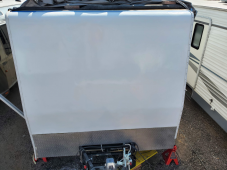I am a heating and air guy. I would not install a conduit. It sounds good but won’t work down the road unless you make it straight and have a large access panel at the top end to form the lines as they exit the top of the chase. I would forget the conduit and install the lines and drain and wire now. The Best would be to install the mini split now. It is the perfect time to do so and you will love it. I have never heard someone say “Boy I sure don’t like that mini split.” Or “Man that thing is noisy.” Or “It sure cost a lot to operate.” I am a cash and carry guy but I would put it on a credit card if I had to while the wall is open.
Thanks for that advice. The rebuild of the front of my trailer is complete and I did not run anything for a future install of a mini-split. The wall is slightly less than 1.5" thick. Running conduit that would easily fit lines for a mini-split didn't seem like it would fit within the wall. The ~90° bend toward the top would have been challenging for the conduit (to fit in the wall) and would probably have been too sharp for the coolant lines.
If I decide to put in a mini-split, I'll run the lines outside the wall.






